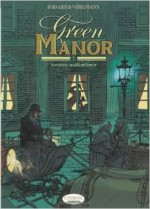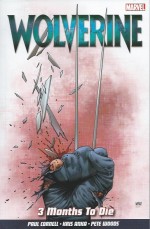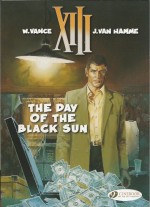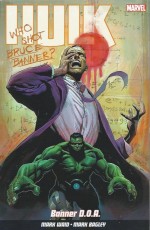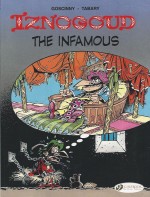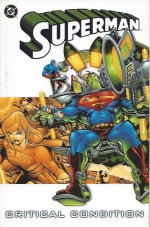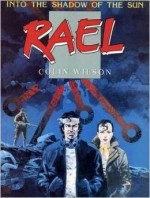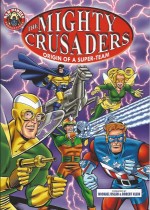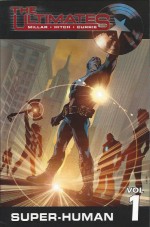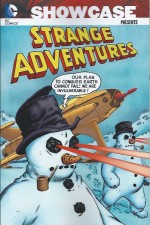
By John Broome, Otto Binder, Gardner Fox, Edmond Hamilton, France E. Herron, Carmine Infantino, Gil Kane, Sid Greene, Jerry Grandenetti & various (DC Comics)
ISBN13: 978-1-4012-3846-9
As the 1940s closed, masked mystery-men dwindled in popularity and the American comicbook industry found new heroes. Classic pulp fiction genre titles flourished; anthologies dedicated to crime, war, westerns, humour and horror were augmented by newer fads like funny animal, romance and most especially science fiction which in 1950 finally escaped its glorious thud-&-blunder/ray guns/bikini babes in giant fishbowl helmets magazine roots (as perfectly epitomised in the uniquely wonderful Golden Age icon Planet Comics) with Julius Schwartz’s introduction of Strange Adventures.
Packed with short adventures from jobbing SF writers and a plethora of new heroes such as Chris KL99, Captain Comet, the Atomic Knights and others, the magnificent monthly compendium (supplemented a year later with sister-title Mystery in Space) introduced wide-eyed youngsters to a fantastic but intrinsically rationalist universe and the wonders it might conceal…
On a thematic note: a general but by no means concrete rule of thumb was that Strange Adventures generally occurred on Earth or were at least Earth-adjacent whilst as the name suggests Mystery in Space offered readers the run of the rest of the universe…
Reprinting Strange Adventures #74-93 (November 1956 to June 1958), this second spectacular sci fi collection features stories from the dawn of the Silver Age, offering a backbone of fantastic fantasy plots and scenarios as an industry-wide resurgence of confidence and creativity gathered momentum and superheroes began to successfully reappear.
These stellar sagas continually informed and shaped DC’s slowly growing heroic adventure revival whilst proving over and again that Weird Science and cosmic disaster were no match for the infallibility of human intellect and ingenuity. During this period many of the plots, gimmicks, maguffins, cover designs and even interior art were recycled for the more technologically-based emergent costumed champions creeping back into public favour…
This mind-blowing, physics-challenging monochrome colossus opens with four classic vignettes, beginning with a terse thriller by John Broome & Carmine Infantino wherein a writer gained the power to see beyond the normal range and became the only human who could combat ‘The Invisible Invader from Dimension X!’ after which ‘The Metal Spy from Space!’ (Gardner Fox, Sid Greene & John Giunta) was similarly exposed and defeated by fictive pulp fictioneer “Edmond Hamilfordâ€â€¦
Fox, Greene & Bernard Sachs then revealed the vested interest of an investigator who obsessively sought out ‘Earth’s Secret Visitors!’ after which Edmond Hamilton, Gil Kane & Joe Giella detailed how a notoriously hapless DIY dabbler found himself in possession of the ‘Build-it-Yourself Spaceship!’
During this period editors were baffled by but still exploited a bizarre truism: every issue of any title which featured gorillas on the cover always produced increased sales. Little wonder then that so many DC comics had hairy headliners…
Strange Adventures #75 led with ‘Secret of the Man-Ape!’ by Otto Binder, Infantino & Giella wherein a scientist intent on evolving apes into men accidentally acquired a test subject who just happened to be the vanguard of an invading alien anthropoid army whilst ‘The 2nd Deluge of Earth!’ (Ed Jurist, Greene & Giella) saw a blind scientist save the world from Martians intent on taking over our water-rich world…
A meddlesome technologist happily makes amends and saves an imperilled alien civilisation after curiously poking his nose into the ‘Mystery of the Box from Space!’ (Binder, Kane & Sachs) before ‘This is Timearama!’ (Hamilton, Greene & Sachs) wittily and scathingly relates what happens when an honest researcher trusts businessmen with the secrets of his televisual time probe…
In issue #76 Broome, Infantino & Sachs explored the mission of a galactic saviour handicapped by fate as he sought to save humanity in ‘The Tallest Man on Earth!’, after which ‘The Flying Saucers that Saved the World!’ (Binder, Greene & Giella) reveals how a professional UFO debunker uses all he’s learned about hoaxes to counter an actual invasion by sinister subterraneans.
Although a short story anthology title, over the run of years Strange Adventures featured a number of memorable returning characters and concepts such as Star Hawkins or Space Museum. Darwin Jones of the Department of Scientific Investigation debuted in the very first issue, solving fringe or outright weird science dilemmas for the Federal Government.
A genius-level scientific detective, he made thirteen appearances over as many years and resurfaced here to foil the insidious schemes of ‘The Robot from Atlantis!’ (Binder, Kane & Giella), which pretended benevolent friendship whilst actually trying to eradicate mankind. The issue then concludes with the struggle of a geologist to get rid of ‘The Hungry Meteorite!’ (Dave Wood, Greene & Sachs) which threatened to absorb all the metal on Earth…
Another Darwin Jones thriller – by Broome, Infantino & Sachs – opened issue #77 when a Death Row convict was given superhuman intellectual abilities by desperate trans-dimension beings facing extinction. However “Lobo†Torrence was prepared to let two worlds die to save himself, forcing the Science Detective to gamble everything on a last-ditch plan…
Hamilton, Greene & Giella then detailed how ‘The Incredible Eyes of Arthur Gail!’ – damaged by a chemical accident and unable to detect non-organic materials – uncovered a cruel criminal plot, Binder, Kane & Sachs exposed the tragic secret of ‘The Paul Revere of Time!’ whose anonymous warnings prevented colossal loss of life and ‘The Mental Star-Rover!’ (Binder, Greene & Giella) revealed an uncanny connection between an Earth author and a piratical alien marauder…
Broome, Greene & Sachs opened Strange Adventures #78 with a spirited mash-up of Arthurian legend and The Prisoner of Zenda as mechanic Bruce Walker pinch-hit for an alien emperor in ‘The Secret of the Tom-Thumb Spacemen!’ after which Fox, Kane & Giella chillingly explored how existence depended on meteors when aliens tried to steal ‘The Life Battery!’ which sustained our bio-sphere…
Binder & Infantino then posed a classic quandary of ingenuity and survival after a prospector was stranded on a primitive island with a dead alien and a matter-transmuting device he believed was ‘The Magic Horn of Space!’ Immediately following, a test pilot was abducted into another dimension to become a guinea pig for inhuman predators in ‘The Prisoner of Space X!’ (France E. Herron, Greene & Sachs).
Issue #79 offered chilly seasonal fare with ‘Invaders from the Ice World!’ by Fox, Infantino & Sachs. When energy beings from Pluto possessed snowmen in advance of an invasion it took all of Darwin Jones’ deductive abilities to fathom their only weakness after which ‘Around the Universe in 1 Billion Years!’ (Herron, Greene & Giella) followed a band of explorers who return to Earth after an eternity in space to discover a new race has supplanted them.
‘A Switch in Time!’ (Fox, Kane & Giella) then examined the fate of a conman who thought himself the lucky recipient of the greatest deal in history before Hamilton, Jerry Grandenetti & Giella reveal the incredible secret of a vehicle which kidnapped its driver in ‘The Living Automobile!’
Binder handled most of the writing in #80, beginning with a smart take on intellectual property as the Kane & Giella illustrated ‘Mind Robbers of Venus!’ saw alien crooks stash their loot in the brain of electronics engineer Ian Caldwell before Greene & Giella took over for ‘The Worlds That Switched Places!’ as an astronaut made a terrible mistake that almost doomed two different dimensions.
Fox & Infantino demonstrated the duplicitous saga of Plutonian Jul Van and ‘The Anti-Invasion Machine!’ which almost destroyed Earth before Binder returned with artist Howard Sherman to seal the fate of an avaricious inventor who believed himself ‘The Man who Cheated Time!’
Strange Adventures #81 featured a subatomic would-be tyrant who kidnapped convict brothers to be his tools in an ambitious plot, but the deranged alien had no idea of the ‘Secret of the Shrinking Twins!’ (Broome, Infantino & Sachs) and consequently paid a heavy price, after which Binder, Greene & Giella pitted an Earth naturalist against a potential world conqueror in ‘The Spaceman of 1,000 Disguises!’
‘The Friendly Enemies of Space!’ (Herron, Kane & Sachs) detailed a series of natural disasters which ruined Earth’s first contact with benevolent extra-solar life before Fox, Grandenetti & Frank Giacoia examined the fallout of a lost artefact from a higher dimension when ‘The Magic Box from Nowhere!’ dropped into the hands of ordinary, greedy humans…
In #82, Herron, Infantino & Sachs’s bellicose and awesome ‘Giants of the Cosmic Ray!’ met their match in a humble earth scientist, whilst a gobsmacked youth was astounded to discover his adoptive parents were aliens when he became ‘The Man Who Inherited Mars!’ (Binder, Greene & Giella)…
A lack of communication would have led to disaster had science fiction writer Owen Bently not deduced the incredible ‘Secret of the Silent Spaceman!’ (Binder, Giacoia & Giella) after which a researcher saved Earth from invaders by turning their technology against them on ‘The Day Science Went Wild!’ (Binder, Greene & Giella).
Strange Adventures #83 found a simple college Professor revealed as an amnesiac chrononaut who had to rediscover and complete his ‘Assignment in Eternity!’ before time ran out (Binder, Greene & Giella again), whilst actor Mark Gordon found himself hunting fans-turned-spree criminals as the ‘Private Eye of Venus!’ (Fox & Infantino) when his hit TV show became the sensation of the telepathic inhabitants of our sister planet…
Herron, Greene & Giella then detailed the misunderstanding which reduced gigantic Good Samaritan ‘The Volcanic Man!’ to the status of an invading monster after which an accident led to brain injury for an ordinary mortal. His wounds were repaired by passing aliens, but the victim then developed uncanny precognitive abilities in ‘The Future Mind of Roger Davis!’ by Herron, Kane & Sachs…
Ray Jenkins was a wealthy man who bought unearned fame and prestige in SA #84, but the glory-hound met his fate when he encountered the ‘Prisoners of the Atom Universe!’ (Broome, Infantino & Sachs) after which a harried scientist prevented ‘The Radioactive Invasion of Earth!’ (Fox, Greene & Sachs) when he realised Martians couldn’t stand his kids’ Rock ‘n’ Roll music either…
Darwin Jones returned to solve the ‘Riddle of the Walking Robots!’ (Herron, Infantino & Giella) which ceaselessly roamed the Earth sowing alien seeds whilst schoolboy Tommy Ward‘s “Electronic Brain†kit became ‘The Toy that Saved the World!’ (Binder, Greene & Giella)… once he stopped scrupulously following the instructions…
John Broome scripted the first half of issue #85, leading with artists Greene & Sachs ‘The Amazing Human Race!’ wherein a scientist uncovered a plot by Praying Mantises to conquer humanity whilst a colour-blind student found affirmation when his disability saved an alien civilisation from destruction in ‘The Colorless World of Peter Brandt!’ (Infantino & Giella).
Binder closed the issue with a brace of tales: ‘The Riddle of Spaceman X!’ (Greene & Giella) saw human scientists try to deduce the form of an alien from examining his “abandoned†ship whilst ‘Thieves of Thought!’ (Infantino & Sy Barry) followed a speleologist who discovered a city of robots telepathically appropriating human inventions for the purposes of conquest…
In SA #86, ‘The Dog That Saved the Earth!’ (Broome, Infantino & Sachs) revealed how alien energy turned an ordinary mutt into a telepathic genius in time to prevent a cosmic catastrophe after which Binder, Infantino & Giella revealed how an ordinary chemist stopped an ‘Interplanetary Space-Feud!’ which threatened to devastate the world.
Gardner Fox then finished off the issue with two intriguing enigmas. Spelunker Bill Jackson stumbled onto an alien ship and found only he could stop ‘The One-Hour Invasion of Earth!’ (art by Giacoia), after which Greene & Giella revealed how schoolboy John Haldane was saved by a mysterious stranger in return for a similar service performed two decades hence during ‘The Weather War of 1977!’
Strange Adventures #87 begins with Herron, Infantino & Giella’s ingenious ‘New Faces for Old!’ wherein the ultimate plastic surgery craze is nothing but a crafty scheme by aliens to ferret out freedom fighters hiding amidst teeming humanity whilst ‘Mystery Language from Space!’ (Fox, Greene & Sachs) shows how a warning of planetary doom was almost wasted since nobody could read the messages…
Next Fox, Infantino & Giella detailed how a freshly graduated Air Force pilot was seconded to the red planet to combat the ‘Meteor Menace of Mars!’ after which Binder, Greene & Giella described how an ingenious writer was tapped by aliens in dire distress to be ‘The Interplanetary Problem-Solver!’
Simian allure informed issue #88 as Herron, Infantino & Giella depicted Darwin Jones thwarting ‘The Gorilla War against Earth!’ and uncovering another alien invasion scheme whilst ‘The Warning Out of Time!’ (Binder, Greene & Sachs) revealed how a lost Da Vinci masterpiece concealed prophetic warnings of future disasters.
A mysterious and diligent ‘Bodyguard from Space!’ (Fox, Infantino & Sachs) attached himself to cameraman Jim Carson because the human’s brain contained knowledge to save a dying civilisation, after which Binder, Greene & Giella posed a classic survival conundrum as Earth scientists struggled to discern ‘The Secret of the Sleeping Spaceman!’
When Saturnians raided our world in issue #89 one scientist advised neither capitulation nor resistance but instead suggested offering ‘Earth for Sale’ (Herron, Infantino & Sachs) to save humanity, after which a professor vanished from human view to find himself a ‘Prisoner of the Rainbow!’ (Binder, Greene & Giella).
Then a pilot on a mission of mercy took an accidental ‘Detour in Time!’ and saved future humanity in a chiller by Fox, Grandenetti & Giella before ‘Mystery of the Unknown Invention!’ (Binder, Greene & Giella) saw a nosy neighbour’s prying accidentally saving a world… but not his own…
In #90 ‘The Day I Became a Martian!’ (Binder, Infantino & Sachs) revealed how prospective invaders periodically transformed a sci fi writer to see if Earth could sustain them whilst Fox, Greene & Giunta recounted how a bookshop owner endured regular clandestine visits from an extraterrestrial seeking ‘The 100,000 Year Old Weapon!’
Binder also scripted the final brace of astounding yarns as an ‘Amazing Gift from Space!’ (illustrated by Infantino & Sachs) saw human suspicion nearly spurn an incredible opportunity and doom two civilisations, whilst Greene & Giella limned ‘Mystery of Meteor Crater!’: a thrilling battle between Jovian invaders and ordinary Earthmen for the most powerful element in creation…
In #91 ‘The Midget Earthman of Jupiter!’ (Broome, Greene & Sachs) saw an Olympic decathlete assist Brobdingnagian aliens in a struggle for democratic freedom whilst Binder, Greene & Giunta’s ‘Warning to Earth!’ featured an oceanographer afflicted with a mental block attempt to circumvent his psychic gag and alert the surface-world to impending undersea invasion…
Fox, Manny Stallman & Giella then detail a shipwrecked extraterrestrial swindler’s scheme to trick Earth into building his ride home after discovering ‘The Amazing Tree of Knowledge!’ before ‘Prisoner of the Space Satellite!’ (Binder, Infantino & Sachs) reveals how an isolated astronomer solves a mathematical mystery and saves the last survivor of Atlantis from death in space…
SA #92 offered a more literal tale from Joe Millard, Infantino & Sachs as ‘The Amazing Ray of Knowledge!’ boosted the intellect of children just as a sidereal phenomenon threatened to destroy the solar system. Sadly the effect was only temporary and when the kids reverted to normal their solution was beyond the ken of their parents…
When an alien impostor dies in an accident the authorities uncover a plot to end humanity. ‘Earth – Planetary Bomb!’ by Fox & Giunta sees Jeff Morgan impersonate his own doppelganger to infiltrate the doom-ring and save the world after which Fox, Stallman & Giella revealed how a magazine artist encountered ‘Models from Saturn’ and became embroiled in an interplanetary revolution.
‘The Ice-Age Message!’ by Binder & Greene then sees a TV weatherman deliver a forecast of meteorological Armageddon after clashing with aliens seeking to steal Earth’s carbon dioxide.
Strange Adventures #93 wraps up the nostalgic future-watching beginning with extra-length thriller ‘Heart of the Solar System!’ (Millard, Infantino & Giella) wherein a space-traffic patrolman strives to protect the artificial organ which regulates the laws of physics in our sector of space from stellar marauders after which Fox, Stallman & Sachs expose temporal meddlers whose experiments drop the first volume of a cosmic dictionary in the lap of a contemporary quiz show contestant.
Dubbed ‘The Wizard of A!’, Joe Bentley‘s brief moment of fame almost eradicated the time continuum…
The final tale in this titanic tome is one last Darwin Jones romp as Fox & Giunta’s ‘Space Rescue by Proxy!’ describes the Science Detective’s dealings with a telepathic alien sent to warn Earth of impending doom. Sadly the saviour himself fell into deadly danger and had to be rescued by Jones’ ingenuity…
Couched in the grand tradition of legendary pulp sci-fi editor John Campbell, with human ingenuity and decency generally solving the assorted crises of cosmic interaction, these yarns and sagas are a timeless highpoint of all-ages comics entertainment.
If you dream in steel and plastic and are still wondering why you don’t yet own a personal jet-pack, this volume might go some way to assuaging that unquenchable fire for the stars…
© 1956, 1957, 1958, 2013 DC Comics. All Rights Reserved.…
